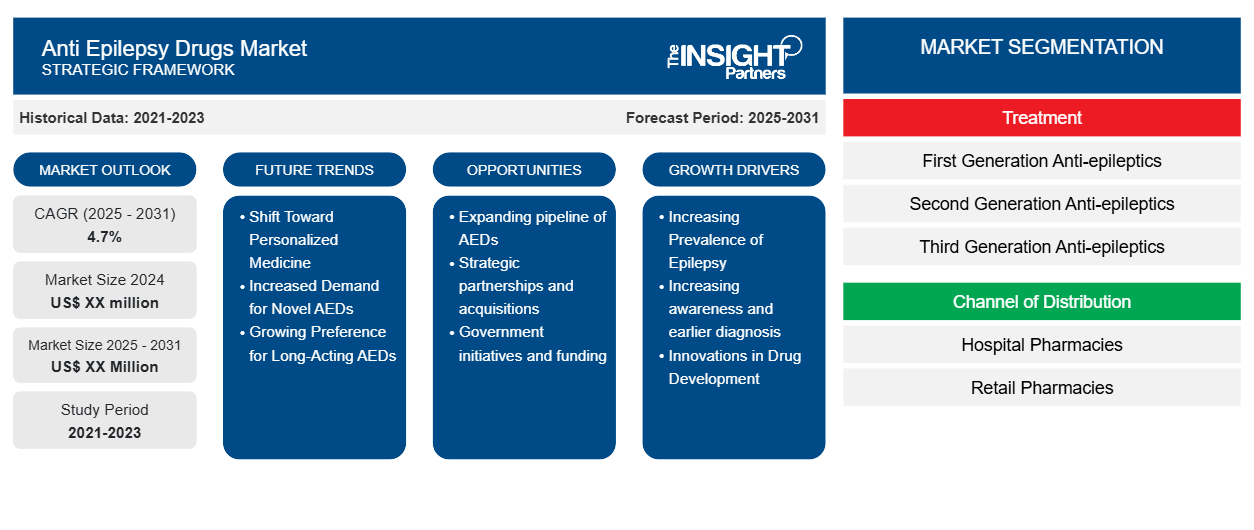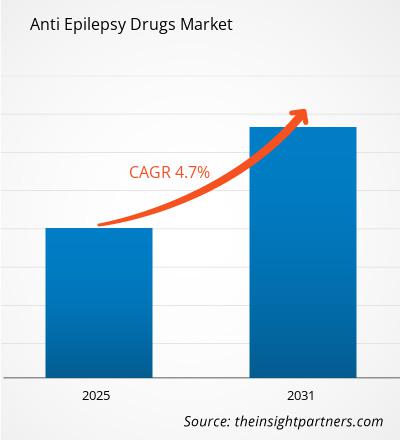The Anti Epilepsy Drugs Market is expected to register a CAGR of 4.7% from 2025 to 2031, with a market size expanding from US$ XX million in 2024 to US$ XX Million by 2031.
The Anti Epilepsy Drugs Market report covers analysis by Treatment (First Generation Anti-epileptics, Second Generation Anti-epileptics, Third Generation Anti-epileptics); Channel of Distribution (Hospital Pharmacies, Retail Pharmacies, Others), and Geography (North America, Europe, Asia Pacific, and South and Central America). The global analysis is further broken-down at regional level and major countries. The report Offers the Value in US$ for the above analysis and segments.
Purpose of the Report
The report Anti Epilepsy Drugs Market by The Insight Partners aims to describe the present landscape and future growth, top driving factors, challenges, and opportunities. This will provide insights to various business stakeholders, such as:
- Technology Providers/Manufacturers: To understand the evolving market dynamics and know the potential growth opportunities, enabling them to make informed strategic decisions.
- Investors: To conduct a comprehensive trend analysis regarding the market growth rate, market financial projections, and opportunities that exist across the value chain.
- Regulatory bodies: To regulate policies and police activities in the market with the aim of minimizing abuse, preserving investor trust and confidence, and upholding the integrity and stability of the market.
Anti Epilepsy Drugs Market Segmentation
Treatment
- First Generation Anti-epileptics
- Second Generation Anti-epileptics
- Third Generation Anti-epileptics
Channel of Distribution
- Hospital Pharmacies
- Retail Pharmacies
You will get customization on any report - free of charge - including parts of this report, or country-level analysis, Excel Data pack, as well as avail great offers and discounts for start-ups & universities
Anti Epilepsy Drugs Market: Strategic Insights

-
Get Top Key Market Trends of this report.This FREE sample will include data analysis, ranging from market trends to estimates and forecasts.
Anti Epilepsy Drugs Market Growth Drivers
- Increasing Prevalence of Epilepsy: Epilepsy is one of the most prevailing neurological disorders affecting millions worldwide. Current research in genetic and environmental factors due to an increase in the prevalence of epilepsy is increasing demand for anti-epilepsy drugs. More patients diagnosed with epilepsy create a need for effective methods of treatment, hence driving this market upward.
- Increasing awareness and earlier diagnosis: Increased awareness of the symptoms of epilepsy and early diagnosis are essentially driving the growth of the market. As awareness about the disorder increases and understanding of it improves, the patients are being diagnosed earlier and are receiving treatment beforehand, which is boosting the demand for AEDs. SK Biopharmaceuticals, a South Korean firm, in July 2023 received regulatory approval in Canada to market its newly developed epilepsy drug, Cenobamate, under the product name Xcopri to further boost sales in the country. Health education of the public and community-based campaigns that create awareness about epilepsy-related conditions have increased the reporting of episodes and related disorders to healthcare providers.
- Innovations in Drug Development: Some crucial drivers for this market include ongoing research in the development of more potent and more targeted AEDs within the pharmaceutical industry. In March 2024, the Children's Hospital of Philadelphia approved The United States Food and Drug Administration to treat the use of the cannabis-derived Epidiolex for epilepsy in neurology. Developments related to new formulations of drugs, designing personal or personalized treatment modalities, or better improvement upon available drugs as side effect reducer drives the higher demand for more new anti-epileptic drugs.
Anti Epilepsy Drugs Market Future Trends
- Shift Toward Personalized Medicine: Personalized medicine is becoming a significant trend in the treatment of epilepsy. With a better understanding of genetic factors associated with epilepsy and their increasing tendency to drugs based on an individual's genetic profile, this new approach promises a more effective treatment with fewer side effects, hence an improved overall patient experience and increased adherence to treatment.
- Increased Demand for Novel AEDs: A new trend in the development and approval of new anti-epilepsy drugs has been observed. UCB showed commitment to its efforts of transforming epilepsy care in December 2023. While attending the AES Annual Meeting, the company managed to release up to 29 studies including the four late breaks. These are specifically targeted at those types of epilepsy that are hard to treat using traditional drugs, such as refractory epilepsy. There is an increased demand for newer AEDs with better pharmacokinetics, fewer side effects, and greater efficacy. This trend demonstrates the industry's efforts to fill unmet needs in epilepsy care.
- Growing Preference for Long-Acting AEDs: Convenience, coupled with patient compliance, makes long-acting AEDs, requiring less number of dosages, a favorite in medical practice. Many patients suffering from epilepsy have a lifelong disease process, and any chronic disorder has the best possible outcome when therapeutic effects last as long as possible, with reduced frequency of dosage. It has led to demand for newer forms of AEDs in the market.
Anti Epilepsy Drugs Market Opportunities
- Expanding pipeline of AEDs: Opportunities for further growth can also be derived through the continuous innovation of new AEDs. Companies are not only focusing on developing drugs against treatment-resistant epilepsy but are also exploring novel mechanisms of action targeted at the causative nature of epilepsy. Therefore, a greater pipeline of promising AEDs is now visible, offering some hope of improvement in patient outcomes for those whose epilepsy is no longer responding to current therapies.
- Strategic partnerships and acquisitions: Pharmaceutical companies increasingly engage in strategic partnerships and acquisitions to enhance the position of an AED provider. Collaboration in biotech organizations, academic establishments, and pharmaceutical companies would accelerate drug development, increase effectiveness in clinical experiments, and also speed up more innovative AEDs into markets. In January 2023, IAMA Therapeutics and PsychoGenics combined to investigate whether new drug candidates could be efficacious in the pre-clinical animal models of Dravet syndrome- a rare epilepsy that causes fatal complications in most children. Such engagements are opening areas for companies for product lines and competitive advantage portfolios.
- Government initiatives and funding: With epilepsy research, new initiatives of the government towards developing new anti-epilepsy drugs open up market opportunities for market players. The increased public funding on research on epilepsy drug therapy, regulatory incentives in terms of fast-track approval, orphan drug designation, and subsidies all present a relatively easier environment for the pharmaceutical industry to develop and launch AEDs.
Anti Epilepsy Drugs Market Regional Insights
The regional trends and factors influencing the Anti Epilepsy Drugs Market throughout the forecast period have been thoroughly explained by the analysts at The Insight Partners. This section also discusses Anti Epilepsy Drugs Market segments and geography across North America, Europe, Asia Pacific, Middle East and Africa, and South and Central America.
Anti Epilepsy Drugs Market Report Scope
| Report Attribute | Details |
|---|---|
| Market size in 2024 | US$ XX million |
| Market Size by 2031 | US$ XX Million |
| Global CAGR (2025 - 2031) | 4.7% |
| Historical Data | 2021-2023 |
| Forecast period | 2025-2031 |
| Segments Covered |
By Treatment
|
| Regions and Countries Covered |
North America
|
| Market leaders and key company profiles |
|
Anti Epilepsy Drugs Market Players Density: Understanding Its Impact on Business Dynamics
The Anti Epilepsy Drugs Market is growing rapidly, driven by increasing end-user demand due to factors such as evolving consumer preferences, technological advancements, and greater awareness of the product's benefits. As demand rises, businesses are expanding their offerings, innovating to meet consumer needs, and capitalizing on emerging trends, which further fuels market growth.

- Get the Anti Epilepsy Drugs Market top key players overview
Key Selling Points
- Comprehensive Coverage: The report comprehensively covers the analysis of products, services, types, and end users of the Anti Epilepsy Drugs Market, providing a holistic landscape.
- Expert Analysis: The report is compiled based on the in-depth understanding of industry experts and analysts.
- Up-to-date Information: The report assures business relevance due to its coverage of recent information and data trends.
- Customization Options: This report can be customized to cater to specific client requirements and suit the business strategies aptly.
The research report on the Anti Epilepsy Drugs Market can, therefore, help spearhead the trail of decoding and understanding the industry scenario and growth prospects. Although there can be a few valid concerns, the overall benefits of this report tend to outweigh the disadvantages.
Frequently Asked Questions
What are the major driving factors impacting the Anti Epilepsy Drugs Market?
What are the future trends of the Anti Epilepsy Drugs Market?
Which are the leading players operating in the Anti Epilepsy Drugs Market?
What are the deliverable formats of Anti Epilepsy Drugs Market report?
What are the options available for the customization of this report?
- Historical Analysis (2 Years), Base Year, Forecast (7 Years) with CAGR
- PEST and SWOT Analysis
- Market Size Value / Volume - Global, Regional, Country
- Industry and Competitive Landscape
- Excel Dataset
Recent Reports
Related Reports
Testimonials
Reason to Buy
- Informed Decision-Making
- Understanding Market Dynamics
- Competitive Analysis
- Identifying Emerging Markets
- Customer Insights
- Market Forecasts
- Risk Mitigation
- Boosting Operational Efficiency
- Strategic Planning
- Investment Justification
- Tracking Industry Innovations
- Aligning with Regulatory Trends





















 Get Free Sample For
Get Free Sample For